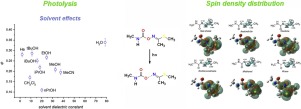Journal of Photochemistry and Photobiology A: Chemistry ( IF 4.3 ) Pub Date : 2020-01-10 , DOI: 10.1016/j.jphotochem.2020.112366 Anđelka Tomašević , Dušan Mijin , Marina Radišić , Nevena Prlainović , Ilija Cvijetić , Danijela V. Kovačević , Aleksandar Marinković

|
This study describes photolysis of 1 × 10–4 M methomyl solution in deionized water and in eleven organic solvents, both polar and nonpolar: methanol, ethanol, n-propanol, isopropanol, sec-butanol, tert-butanol, isobutanol, isopentanol, n-hexane, acetonitrile, and dichloromethane. Photolysis of methomyl at 254 nm was performed using Osram mercury lamp (6 × 8 W) by exposing to irradiation for five hours. All photolytic methomyl reactions were studied by UV/Vis spectroscopy within a wavelength range of 190−300 nm (Spectrum Mode), and at 233.4 nm (Quantitative Mode), while the rate of photodecomposition of methomyl was measured using UV spectroscopy and HPLC. In order to get better insight in the photolysis of methomyl, a liquid chromatography-mass spectrometry (LC–MSn) was used. The rate of methomyl photolysis was solvent-specific and the following reaction rate order was established: deionized water > tert-butanol > n-hexane > sec-butanol > ethanol > isopentanol > isobutanol > isopropanol > methanol > acetonitrile > dichloromethane > n-propanol. Both nonspecific and specific solvent-solute interactions contribute mutually to the differences in the obtained quantum yields. Results of quantum chemical calculations, using CBS-QB3 method, provided insights into the solvent effects on both ground and excited state. The LC/MSn analysis showed the formation of several photolytic products.
中文翻译:

杀虫剂灭多威在各种溶剂中的光解:实验和理论研究
这项研究描述了在去离子水和11种极性和非极性有机溶剂中1×10 –4 M甲基苯甲基溶液的光解:甲醇,乙醇,正丙醇,异丙醇,仲丁醇,叔丁醇,异丁醇,异戊醇,n-己烷,乙腈和二氯甲烷。使用欧司朗汞灯(6×8 W)在254 nm处进行光解,照射5小时。在190-300 nm(光谱模式)和233.4 nm(定量模式)的波长范围内,通过UV / Vis光谱学研究了所有的光解甲基苯丙胺反应,而使用UV光谱学和HPLC测量了甲基苯丙胺的光解速率。为了更好地了解灭多威的光解现象,使用了液相色谱-质谱联用法(LC-MS n)。灭多威的光解速率是溶剂特定的,并建立了以下反应速率顺序:去离子水>叔丁醇>正己烷> sec-丁醇>乙醇>异戊醇>异丁醇>异丙醇>甲醇>乙腈>二氯甲烷>正丙醇。非特异性和特异性溶剂-溶质相互作用都共同导致所获得的量子产率的差异。使用CBS-QB3方法进行的量子化学计算结果可洞悉基态和激发态的溶剂效应。LC / MS n分析表明形成了几种光解产物。



























 京公网安备 11010802027423号
京公网安备 11010802027423号